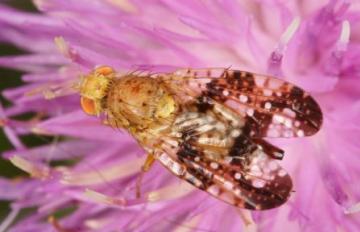Species Account for Acinia corniculata
Acinia corniculata (Zetterstedt, 1819)
Diptera: other groups: Tephritidae

Reproduction for study and non-profit use permitted, all other rights reserved.
Taxonomic group: flies (other) (Diptera: other groups) - County data
View time series maps for Acinia corniculata
member log-on for taxon report
Status: RDB 1
Images
upload a new image
Essex Red Data List comment
Recorded from 1 out of 57x10km.sq. records in county
Species text
This picture winged fly is recorded from scattered localities in southern England, but in Falk (1991) there were only three known post 1960 sites. In 1995 it was recorded from an old covered reservoir in Peckham. It is not however one of the tephritid species that has shown an increase in range or frequency in recent years. The species occurs in meadows, fens and drier grassland. The larvae have been reared in Germany from flowerheads of the brown knapweed Centaurea jacea, but in England it almost certainly uses common knapweed C. nigra. Management should maintain a rich and varied flora including strong populations of knapweed, using rotational grazing regimes on larger sites to produce a mosaic of vegetation types (Falk, 1991). Like most British tephritids this species has a life system strategy where the larvae develop in 20 to 40 days and pupate in the host tissue, in this case the dry fruit heads, which exist throughout the winter (White, 1988). Hence cutting would decimate the population. Extensive areas of knapweed should be left uncut each year to ensure continuity. References
Habitats
Recorded management for locations with Acinia corniculata
Recorded substrate and hydrology for locations with Acinia corniculata
Why not join the Club, register and add a new species page
Interpretation of distribution maps



















